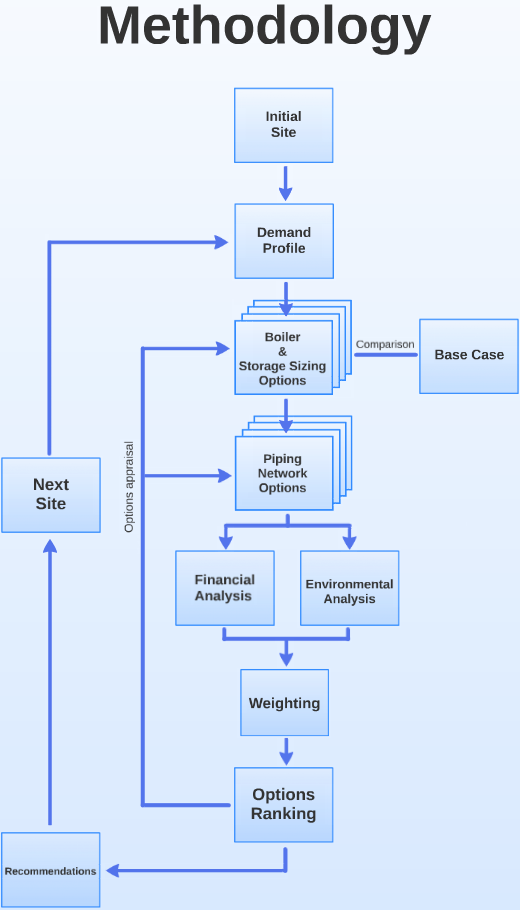Project Overview
Reasons
This project focuses on biomass DH potential within the UK. It aims to determine the technologies technical, financial and environmental feasibility. The aim is predominantly financial, as the is the main driving force behind government policy and client implementation. This is a renewable energy driven technology which is not common practice within the UK. This project aims to understand why and determine if there are benefits to promoting its growth.
At present, rising energy bills and energy security concerns are high on the government and public’s agenda. Stringent environmental targets have been set to promote sustainable economic development and a sustainable future, with regards to energy. Biomass driven district heating may well play an important role in this.
East Dunbartonshire Council and Campbell Palmer Partnership Collaboration:
Initially, the East Dunbartonshire Council contacted the Campbell Palmer Partnership to enquire about the potential for a biomass district heating scheme for the town of Kirkintilloch, Scotland and its surrounding area. They were inspired by the implementation of the technology b the Aberdeen City Council, as a way to ensure financial savings and meet carbon emission mandates.
The council has stringent environmental targets set by the national government. They also pay a fixed cost of £13 per tonne of CO2 emitted from council operated properties. This is due to rise to £15 per tonne. To add to this, the council has faced budgetary cutbacks due to the economic situation of the past number of years. From a councils perspective, Savings = Jobs = Improved local Services. A feasible biomass DH scheme may be of great benefit to the local community as a whole. Many of the council owned properties are performing poorly, from an energy point of view. Improvements are required to deal with rising energy bills. The council is keen to tackle the problem with a renewable energy and sustainable solution, if possible. A national grant may be available to aide with high capital costs. Even if this is not obtained, RHI payments will be guaranteed.
Both parties then contacted the University of Strathclyde, in order to collaborate with a student body to help with their feasibility analysis. From here, our group chose this general outline and used it to form our own focus on biomass DH.


Approach
After we received the proposal from the council and consultancy and met with both parties, a project outline was formed. Our aim and objectives were established. Following this, our project methodology was formed. This methodology will enable a client to complete a high-level feasibility check as all processes and input data required are outlined clearly. This may be seen below:
 Upon attempting to perform an initial analysis on a carefully selected grouping of council buildings, it was clear that a well-defined methodology was critical. This was an iterative process as we were originally unclear as to how to integrate each step, to meet our aim and objectives. The finalised methodology is shown here. This is a general methodology that is not site-specific. This was one of the key objectives of the project. This may be used on any cluster of buildings to determine the feasibility of biomass DH. Prior to this project, no single public design tool could be found to analyse biomass driven DH from a technical, economic and environmental perspective. This methodology incorporates a number of design tools in order to perform a complete feasibility analysis of a site. This will become clearer in the ‘Key Processes’ section.
Upon attempting to perform an initial analysis on a carefully selected grouping of council buildings, it was clear that a well-defined methodology was critical. This was an iterative process as we were originally unclear as to how to integrate each step, to meet our aim and objectives. The finalised methodology is shown here. This is a general methodology that is not site-specific. This was one of the key objectives of the project. This may be used on any cluster of buildings to determine the feasibility of biomass DH. Prior to this project, no single public design tool could be found to analyse biomass driven DH from a technical, economic and environmental perspective. This methodology incorporates a number of design tools in order to perform a complete feasibility analysis of a site. This will become clearer in the ‘Key Processes’ section.
This methodology has been used to perform the high-level, strategic review of biomass driven district heating for a specific case-study. This aspect of the project has helped the council and consultancy meet their specific aim.
The overall project, grouped with the use and development of new and existing design tools, has enabled the group to deliver general and site-specific conclusions for biomass district heating within the UK.






